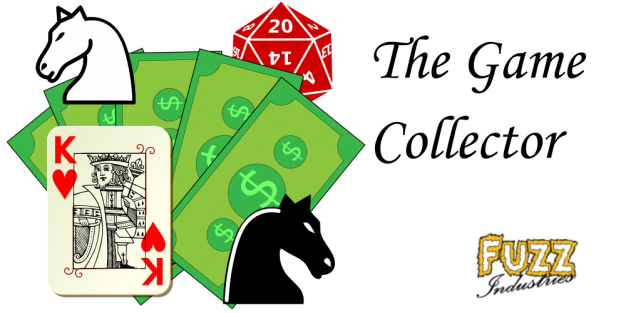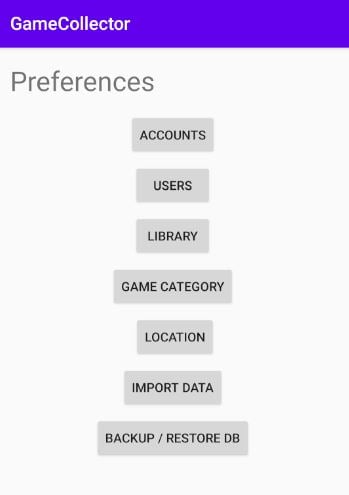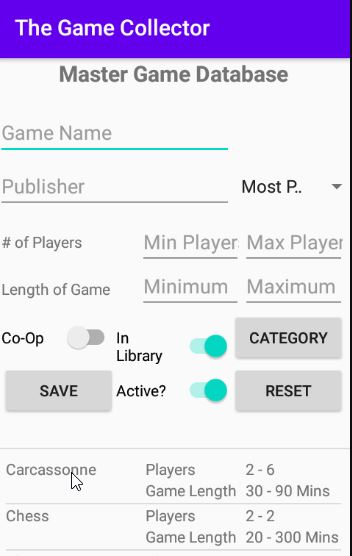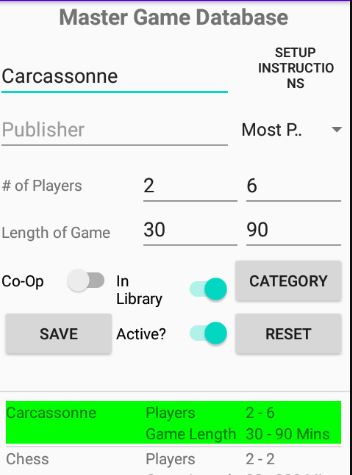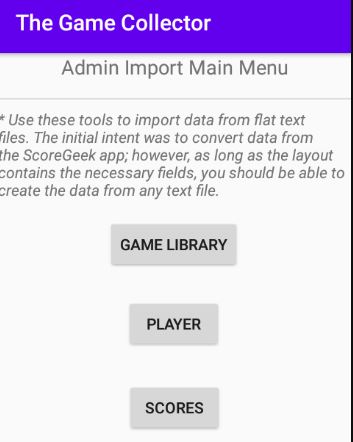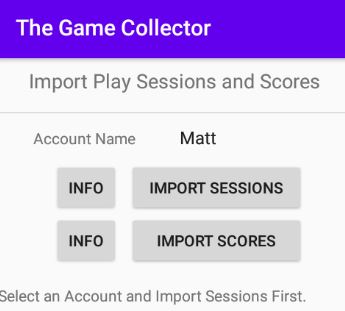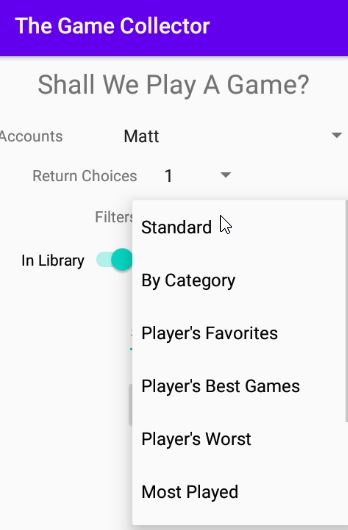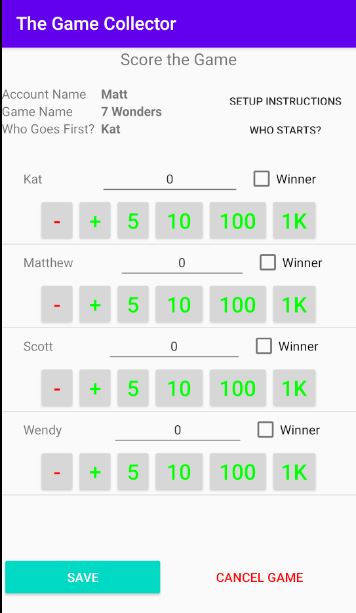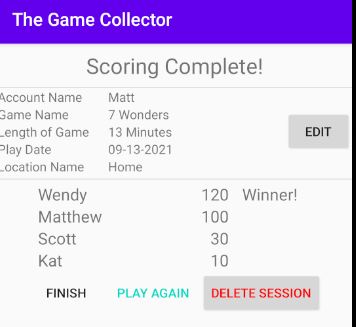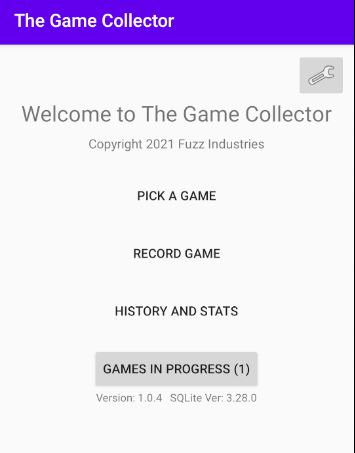How to Use The Game Collector
For Version 1.0.4
Setup
Accounts:
After you install the app on your device, you will be asked on your first running of the application to create an account on the Game Collector. An account is a local construct that allows you to separate game plays and players. There is future plans to use this to link to either a Google Drive account to allow for online backups, but these features are still under development.
You can create as many accounts as you want, but remember that while the game library is shared across accounts, players and plays are not. At this time, stats are constrained to a single account.
Users / Players:
User’s or players are necessary for tracking statistics and game plays. User’s are unique to an account. It is best to give each player a unique name, but the system will permit duplicates. The email address for each player is optional, and their for future enhancements.
You can mark a player/user as a favorite user. This places that player at the top of the order when selecting players for recording a gaming session, otherwise, players are listed in alphabetical order.
Active, indicates that the player should show up in drop down lists for selection. Inactivating a user/player removes them from active selection for gaming sessions, but they can still be reactivated for later. Their stats and sessions are preserved.
The Set Favorites button is for assigning that player’s favorite games in the library. This feature only works once games have been entered into the library. You may assign up to 10 favorite games. Each favorite can be assigned a rank, which is not currently in use, but there are future plans to utilize that in rendering statistics.
Library:
The Game Library is where you will enter in your game collection. There are lots of options here, but the Game Name is the only required field.
You have the ability to set the minimum and maximum number of players the game can support. This is useful when using the randomizer in retrieving games that meet your groups size.
The Length of Game allows you to store the time range in minutes a given game takes to play. This is used by the game randomizer to help you find a game that fits within your allotted time.
Some games are considered Co-Operative. When entering in a game of this type, it is best to set the Co-Op switch on.
By default, every game you enter is included in your personal library. However, you may want to track game plays with your friends that you do not own personally. You can therefore turn the In Library game switch off, to help you when randomizing game selection.
Active allows you to turn games off that you no longer play to reduce the size of various drop down lists within the application. The data for the game is preserve, but it takes it out of your way.
The Category button allows you to assign various custom categories to each game. This assumes you have created at least one or more category in the system before using. Categories are used for statistics reporting and for game randomization.
Scoring Method: The scoring method drop down allows you to determine how winners are validated when a game is scored. The default value is by the Most Points. Other options include the Least Points for games like Phase 10 or Golf, or Win/Lose for games like chess. Selecting Win/Lose will also remove the points inputs during the scoring phase to make the screen more compact.
Setup Instructions: Once a game has been selected, the user can update any information related to the game including the name. You will also notice a new option next to the game name, Setup Instructions. This feature allows you to enter in custom or simplified setup instructions for a given game based upon the number of players playing.
Games will often tell you to use a reduced number of one or more components depending on the number of players. Rather than have to dig out the original rules and find it, you can simply enter the text in the respective player space and it will be available for you when you start recording a gaming sessions.
Game Categories:
This is the manager that allows you to setup as many custom categories as you would like. These categories then get assigned to a game via the Category button on the Library screen.
Categories are shared between accounts and are used in the game randomizer and various statistics reports.
Location:
When recording a gaming session, you can specify location to track where the session was played. This is useful if you are tracking game sessions for lots friends and frequently rotate locations. One location can be set as the Default location, which makes it the first to appear when starting the gaming session.
Importing Data
When creating the app, one of the key features incorporated was the ability to import data from other sources. It is important to note that the system can use data from any system, so long as it follows the specified CSV format (See Import Templates). Data can be imported from scratch or after you’ve already started your library.
Currently, the system supports importing the game library, players, and gaming sessions.
Game Library: When games are imported into the gaming library there are two key elements that should be included: the Game Name and a Unique ID.
If the game name already exists in your library, the existing game will be updated with the Unique ID. This Unique ID is when importing gaming sessions, should you choose to do this. There are numerous fields that are unused in the format at this time, but it is important to keep the layout the same regardless.
The file you want to import, should be placed in the accessible portion of the android device.
Players: When importing players, there are currently only two fields that are used, Name and Unique ID. As with the library, if the Player Name already exists, the system will update it with the Unique ID which is then used to match up gaming sessions. Players are imported into a specific account. If you want the same players to be available in multiple accounts, you simply run the import a second time with the other account selected in the dropdown.
Scores: Importing scores into the Game Collector is a two step process. Scores can ONLY be loaded if games and players are first loaded with UNIQUE ID’s.
Importing sessions must be done first. You will establish a Unique ID for each session, which will be used for loading the Individual Scores. You will also need to associate the session with the Unique ID of the Game that was played.
If the date/time for the game session is recorded, it should be represented as integer of the number of milliseconds since 1/1/1970. This is a common computer representation for a given date.
Import Scores allows you to transfer all you precious legacy gaming scores. The import scores can only be run after the Import Sessions has been run. Each Score has the following fields that are needed. Score ID is a unique id for each record. This can be any type of value so long as it is unique for each score entry. The Session ID is the Unique ID specified for each session created in the previous step. The Player ID is the Unique ID assigned to each player in the Import Players step. Points, is the value the player scored for that gaming session and should be a numeric value. Win, is a Boolean value that determines which player actually one the game. This should be represented as a 1 for a win, or 0 for a lose.
Backup and Restore Database
The Game Collector uses the open source database platform SQLite. This makes the database portable and easily viewable outside of the application. For this reason, you can backup the SQLite datafile to an accessible location on your Android device, so that it can be moved to another device or shared with another user. In rare cases, you may be asked to submit the backup file to technical support in order to troubleshoot an issue.
Restoring from a backup file, permanently deletes the existing database, so be sure the file you are recovering is the correct one.
Pick a Game
One of the unique features of the Game Collector is the game randomizer. This tool is for those who have the hard decision to make of which game to play next. The randomize can simplify that for you and even save you a step when recording a gaming session.
Return Choices:
The Game Randomizer will return a predetermined number of results so that you can still have a little say in the matter. The selection allows you to pick between 1 and 3 games returned during each randomization.
Filters:
The filters allows you to determine what kind of methodology the randomizer should use to select the games.
Standard:
Include everything that is currently active.
By Category:
If you are using game categories, you can randomize by one or more categories of games. This helps if you are in the mood to play a particular style of game.
Player’s Favorites:
If you assign player favorites, then you can use this to randomize from one or more of the player’s favorites.
Player’s Best/Worst Games:
This feature pulls from the games with the highest/lowest winning percentage. You are also presented with a factor of what percentage to grab within that subset. 50 percent is the default.
Most/Least Played:
This randomization model, determines the most/least played games within the library. The user then has the option of targeting a certain percentage of those before randomization.
Longest Since Played:
This randomization model targets games that have not been played in a while. While the Most/Least focuses on quantity, this targets timeframe. The randomizer takes the games with the longest time since played ignoring games never played, and then randomizes them.
Starting a Game from the Randomizer:
Once the randomizer has displayed it list of game options, you have the ability to either trigger the randomizer again (assuming you did not like any of the options), or selecting one and going to start the game. The advantage of starting the game from here is that the Record Game screen is prepopulated with the selected game.
Record Game
In this section, we will focus on how to record a gaming session, and all of the features contained within the interface.
Start a New Game
Whether you enter this screen from the main menu or from the randomizer, this screen behaves the same.
Make sure the correct account is selected first. In most cases, there should be only one.
Next review the list of games using the dropdown. If you used the randomizer, this will already be selected for you. You can still change your mind if you want.
Should you not see a game that you are expecting to play, return to the Library manager in the settings and verify that the game in question has not been Inactivated.
The player selection should display any favorite players in alphabetical order on top, then the remainder of your player list in alphabetical order below. Select your players appropriately before hitting Go. A game timer begins at this point tracking the amount of time spent on the game.
Individual Game Stats:
In most cases, you will see a popup box displaying the players you have selected and their stats respective to the game you are about to play. This will include overall average scores as well as individual scores.
At this time, games that are Win/Lose type games where no points are scored, do not trigger this popup, and you will go directly to the Score Game screen.
Scoring the Game
This page has many things going on. At the top, you will see the account and the game name for the game in progress. Below that you will see a randomized player’s name for who should go first. If for some reason, this player chooses not to go first, or the group wants someone else to go first, Press the “Who Starts?” button to randomize again the starting player.
For some games, you may have entered in custom setup instructions. You should see another button “Setup Instruction” which will display a popup showing you those instructions, if available.
As the game progresses, you can enter the score by using one of the pre-defined buttons, or by clicking in the value field itself and typing in the exact score, whichever is easiest for you.
Should the game be scrapped for any reason, you can Cancel Game, to remove the game from the database.
In most cases, the system can determine the winner automatically based upon the scores provided. Should there be a time, use one of the check boxes to determine the player deemed the winner.
In a Win/Lose style of game, ignore the score and check the box adjacent to the winning player.
Leaving the Game Collector during this page, creates a game in progress, which you can return to from the main page at a later time.
Scoring Complete!
This page recaps the information supplied on the Score the Game page, and includes a rough time spent playing the game. The Edit button allows you go edit attributes of the sessions, such as the total time spent, the location of the match, the date of play so that you can record games previously played or event the game itself. However, you cannot adjust the scores at this point. If the scores were incorrectly supplied or for some reason the wrong winner selected, the session will need to be deleted and reentered.
If you want to play the same game with the same players again, simply hit Play Again to go back to the Start a New Game screen with all of the key elements prepopulated for you.
Finish returns you to the main page.
Games In Progress
Should a game be interrupted, or a problem with the app occurs, you will most likely be able to continue the game via the Games In Progress button which only appears if the system detects 1 or more open games.
In the event that you have multiple games open, when you click on the button, you will be provided with a list of those open games, and you can select which one to resume. The system will then take you back to the Score the Game page with all of the previously saved data intact.
You can also choose to delete open sessions, if the game has been abandoned.
History and Stats
The History and Stats page has two modes as the name implies. The first is gaming history. If you want to see the history of gaming sessions you have recorded, use the Get History button in conjunction with the Player and Game Name drop downs to review the history. Tapping on an entry in the history list will take you to the Score Complete page where you can review the details of the gaming session, edit certain attributes and even delete the session if it was a mistake.
View Stats
This page allows you to generate a wide range of charts showing various game stats. Several of the charts are considered drill-down charts which allows you to tap a certain player/region of the chart to drill down into more detailed information.
High Level Reports include Overall Wins, Win Percentage, Games Played, Category Breakdown, and Player Win History (only on newer versions of Android).
Players that are marked as inactive in the User / Player settings will not be included in the output of the graphs, however, their plays will still impact various statistics.
Overall Wins
This displays a pie chart of overall winners in your system. The pie chart space is limited to the highest winners. The name and number of wins recorded for each player appears respectively in the pie. Tapping on a player, will take you to the Win/Loss chart which shows the individual’s wins and losses per game. The slider at the top of the chart allows you to move back and forth across the games played by that player.
Win Percentage
This chart displays each player’s overall winning percentage from highest to lowest. You can use the slider bar to navigate through your player roster. Tapping on a player’s percentage bar, will drill down into the player’s individual winning percentage per game starting with their highest and moving to their lowest.
Games Played
This bar chart quickly shows you which games have been played to most. You can use the slider at the top to navigate across all the games in your library. By tapping on an individual game, you will be taking to the individual wins for that game by each player.
Category Breakdown
The Category Breakdown Pie Chart, if categories are in use, will show you the number of games in each category played. Tapping on a specific category will drill-down to the breakout of each game played within that category.
Play Win History
Currently, this chart is only available on the Android 9 and above. This chart is driven by an individual player and shows their respective rolling win percentage over time.
Specify Dates
The graphs and charts can be limited by a specific date range. This is useful if you are having a friendly competition within your group, or if you want to see what was played during your vacation time. A Start Date and End Date is required for the date range to work.
